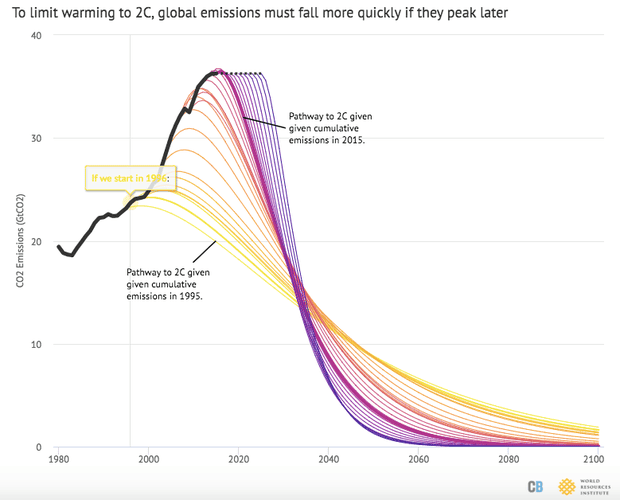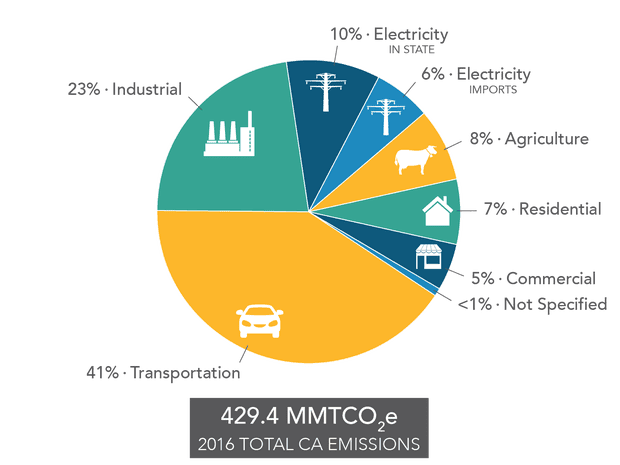
Last week, California Governor Jerry Brown signed State Senator and US Senate candidate Kevin de León’s SB 100, which mandates that the state obtain all of its electricity from zero-carbon sources by 2045. That in itself was a big deal, but Brown didn’t stop there; he also issued an executive order calling for the entire California economy to become carbon-neutral by 2045. That’s a huge deal.
In order to stay below the Paris climate threshold of 2°C global warming above pre-industrial temperatures, humanity must become carbon-neutral by around 2060 or 2070. If California can meet Brown’s target, it will be providing the rest of the world a blueprint for meeting the Paris target. As the world’s fifth-largest economy, California can provide a powerful roadmap for others to follow.

Global emission reduction trajectories associated with a 66% chance of avoiding more than 2°C warming by starting year. Solid black line shows historical emissions, while dashed black line shows emissions constant at 2016 levels. Data and chart design from Robbie Andrew at CICERO and the Global Carbon Project. Illustration: Carbon Brief
Brown’s executive order directs the California Air Resources Board (CARB) to work with relevant state agencies to develop a framework for implementation and accounting of progress toward statewide carbon neutrality. While state agencies can figure out a plan to achieve carbon neutrality, the state legislature will have to pass laws to implement that plan.
California has been all-in on tackling climate change, as its carbon cap and trade system and SB 100 illustrate, but Californians will have to keep electing climate realists to state office in order to make the dream of carbon neutrality a reality.
SB 100 tackles the electricity sector, but because California has long been transitioning toward clean energy, electricity now only accounts for 16% of the state’s greenhouse gas emissions. Transportation accounts for the biggest chunk at 41%. Brown has been pushing for a transition to electric cars, signing another executive order earlier this year setting a goal of 5m EVs on the road by 2030, and several bills last week to help expand their use.

California greenhouse gas emissions by sector. Illustration: California Air Resources Board
While California has the most EVs on the road today (both total and per capita) of any state, they still only account for 5% of new car sales, with 380,000 sold so far. Accelerating that transition toward EVs is crucial for meeting the carbon neutrality goal, and it’s the main reason why California is fighting the Trump administration’s efforts to freeze fuel efficiency standards and take away the state’s ability to set its own.
The industrial sector accounts for another 23% of California’s greenhouse gas emissions. About half of that comes from the petroleum industry – predominantly from drilling for oil and natural gas, as well as oil refining. California is the fourth-largest oil producing state. The Trump administration wants to increase that number and is contemplating opening 1.6 million acres in California held by the Bureau of Land Management to fracking and oil drilling. But a wiser future president could revoke those drilling leases on federal lands, and California could ban drilling and fracking on state lands. That’s a bridge too far for Jerry Brown, and protesters have been criticizing him for it, but it’s easy to imagine a future governor taking this step.
Agriculture and forestry account for another 8% of California’s greenhouse gas emissions. The state is already launching a Healthy Soils Initiative to increase carbon sequestration via farming. For example, one pilot project is monitoring how much carbon will be stored by clover planted between trees at an almond orchard. The University of California at Davis is also conducting experiments to evaluate how changing livestock feed can reduce methane emissions from cattle.
Another 7% comes from the residential sector, most of which is due to burning natural gas for heating and cooking. But stoves, hot water heaters, and heating units can be replaced by electric appliances powered by California’s increasingly carbon-free energy. Last week, Brown also signed a bill directing CARB to study ways of cutting carbon pollution from residential and commercial buildings.
Posted by dana1981 on Monday, 17 September, 2018
 |
The Skeptical Science website by Skeptical Science is licensed under a Creative Commons Attribution 3.0 Unported License. |